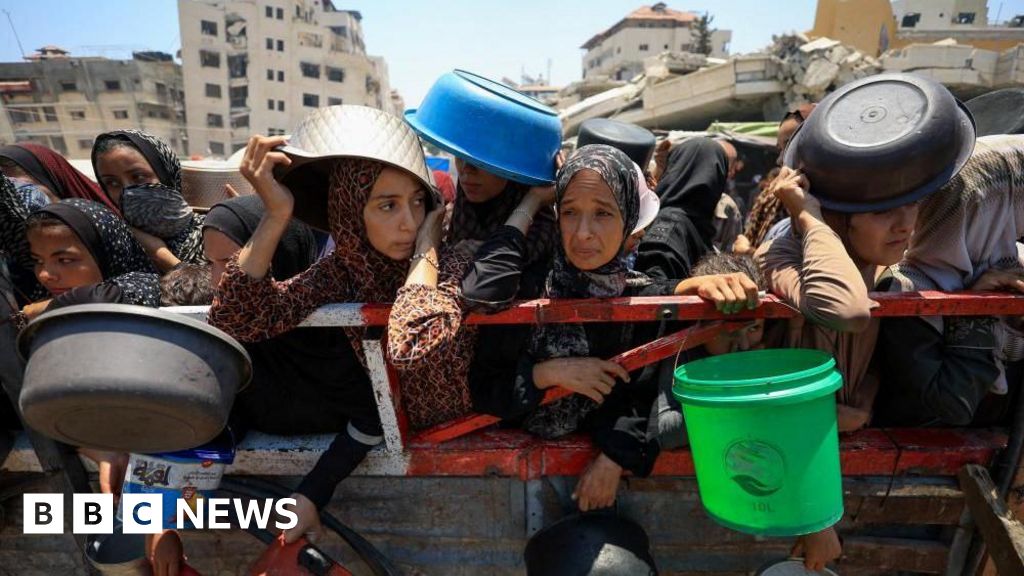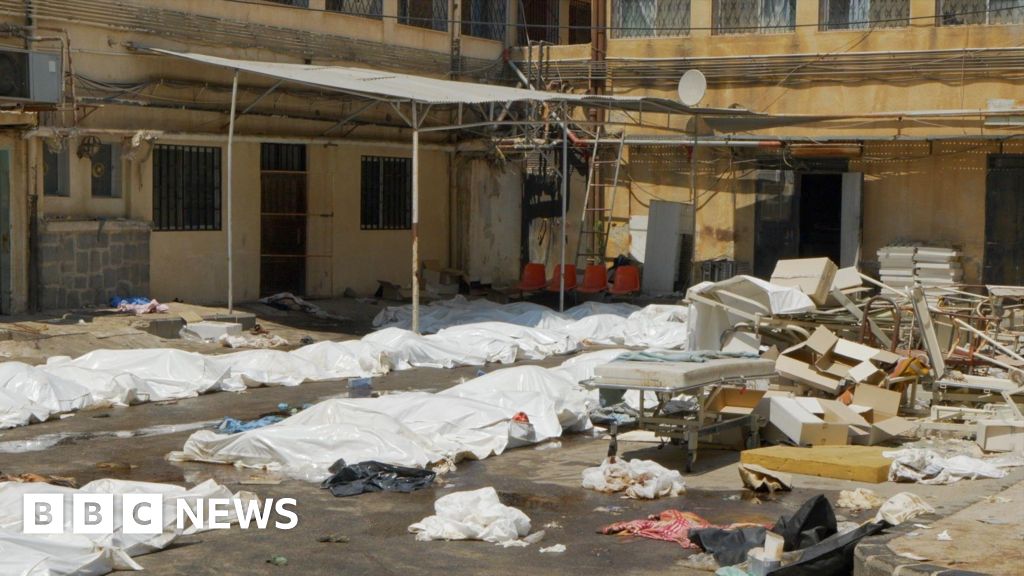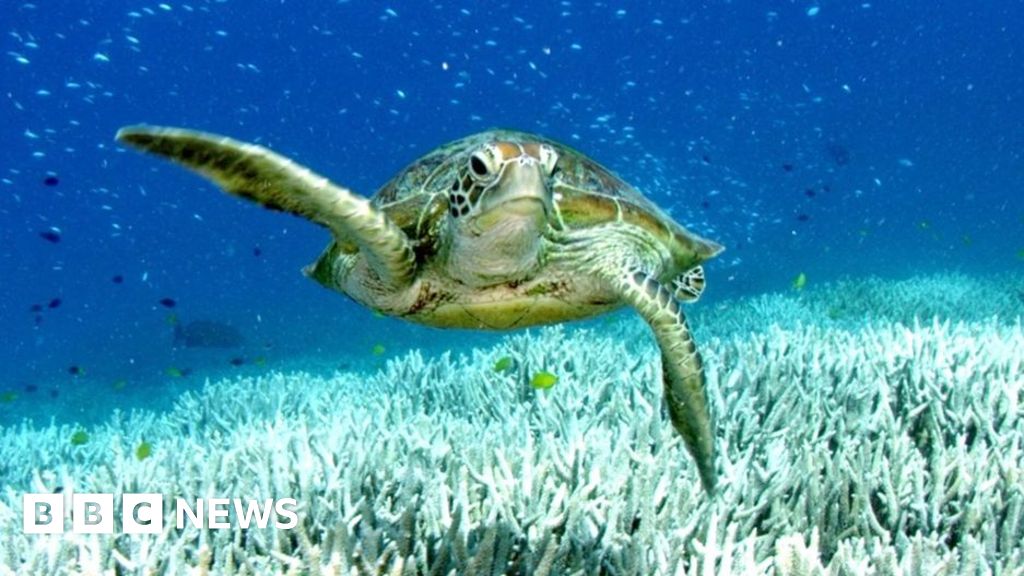【珊瑚界的"集体中暑":澳洲双海岸遭遇史上首次同步白化】当澳大利亚东西海岸的珊瑚礁首次同时"集体美白",科学家们惊呼这比海底火山喷发还罕见!宁格鲁礁——这个能让你穿着拖鞋就能浮潜的世界最大岸礁,如今正被科学家称为"水下丛林大火"烤得发白。更讽刺的是,就在受灾海域不远处,政府刚批准了全球最大化石燃料项目延期运营至2070年。游客痛心描述:"就像在尸体上浮潜,连鱼啃珊瑚的声音都听不见了"。环保专家怒斥:"一边是珊瑚在热浪中垂死挣扎,一边却在审批新天然气项目,这就像给高烧病人递香烟!"
The 'underwater bushfire' cooking Australia's reefs
"水下丛林大火"炙烤澳大利亚珊瑚礁
1 day ago Share Save Katy Watson Australia correspondent Reporting from Western Australia Share Save
(1天前 凯蒂·沃森 BBC澳大利亚记者 发自西澳大利亚)
Watch: Can you un-bleach coral? BBC visits remote Australian reef to find out
(视频:珊瑚能"去白化"吗?BBC探访澳大利亚偏远礁群)
Australia boasts plenty of superlatives when it comes to its natural landmarks. The Great Barrier Reef, the world's biggest coral reef system on the north-east coast, is rightly recognised as a Unesco World Heritage Site. Buzzing with biodiversity, it's a diver's dream. But there's a lesser-known record breaker on the other side of the country, on Australia's north-western coast: Ningaloo Reef. A 14-hour drive north of Perth, Ningaloo is unique. The world's largest fringing reef and another of Australia's Unesco World Heritage Sites, it is home to a lush oceanic forest that spreads out along the coast for hundreds of kilometres. From the region's remote desert beaches, you can wade into vibrant turquoise waters and almost immediately start snorkelling in a seascape as famous for its vibrant corals as the wildlife that surrounds them - manta rays, reef sharks and whale sharks. But this year, Ningaloo has found itself in trouble. Hit by a marine heatwave, higher water temperatures have stressed the corals and they've been turning white, in an effect known as 'bleaching'. While some may recover, it's not a given – and the damage has astounded scientists. Not only that, but the heatwave is responsible for another, more worrying superlative. This is the first time that the reefs on both Australia's western and eastern coasts have been bleached."It's like a raging underwater bushfire that has persisted for months now, wreaking harm right along the coast," says Paul Gamblin, who heads up the Australian Marine Conservation Society."It's an absolutely devastating event and people are reeling from it. It is enormous. It's unprecedented. It's absolutely not normal."
澳大利亚自然景观拥有多项世界之最。东北海岸的大堡礁作为全球最大珊瑚礁系统被列为联合国教科文组织世界遗产,其丰富的生物多样性令潜水爱好者神往。而在该国另一侧的西北海岸,还隐藏着另一个纪录保持者——宁格鲁礁。这个距珀斯14小时车程的世界最大岸礁同样是世界遗产,孕育着延绵数百公里的繁茂海洋森林。从偏远沙漠海滩踏入碧蓝海水,瞬间就能与珊瑚礁和蝠鲼、礁鲨、鲸鲨等海洋生物共游。但今年宁格鲁陷入危机,海洋热浪导致水温升高引发珊瑚白化。虽然部分珊瑚可能恢复,但受损程度令科学家震惊。更令人担忧的是,这是澳大利亚东西海岸珊瑚礁首次同时白化。澳大利亚海洋保护协会负责人保罗·甘布林形容:"如同持续数月的水下丛林大火,这是绝对灾难性的、前所未有的异常事件。"
Getty Images
(盖蒂图片社)
What's going on?
(事件背景)
The marine heatwave that's damaging Ningaloo started in the Caribbean in 2023 . It then made its way across the Indo-Pacific, damaging coral reefs in its path. In 2024, while the Great Barrier Reef saw bleaching, Ningaloo was spared. But by the end of last year and the beginning of 2025 – peak summer – temperatures had begun to soar in Western Australia. It's all part of the fourth global bleaching event, which experts say has affected more than 80% of the world's coral reefs. Dr Kate Quigley, principal research scientist at Minderoo Foundation, likens the effect to a stomach bug."Instead of having bacteria in the human gut, corals have this little algal symbiont that lives inside their cells that allow them to do biological processes," she explains, adding that this algae is what gives the corals their colour. When water becomes too warm, that relationship breaks down and bleaching begins."So, kind of like, if we got a stomach bug and the human body doesn't function the same way, [it's the] same thing with the coral," she explains."The warm water causes the biological processes inside that coral to go haywire. And just like humans get sick, corals get sick too." Of particular worry to Dr Quigley is the prolonged warming scientists have seen. They expected temperatures to drop by April as peak summer passed. This year, that didn't happen.
这场始于2023年加勒比海的热浪穿越印太地区,沿途摧毁珊瑚礁。2024年大堡礁出现白化时宁格鲁幸免,但2024年底至2025年初夏季高峰时西澳水温骤升。这是第四次全球白化事件的一部分,专家称全球超80%珊瑚礁受影响。明德路基金会首席科学家凯特·奎格利博士将白化比作胃部感染:"珊瑚体内的共生藻类如同人体肠道菌群,水温过高会破坏这种关系导致白化"。令她担忧的是,往年四月夏季高峰后水温会下降,但今年持续高温异常。
Getty Images Ningaloo is the world's largest fringing reef, home to an oceanic forest that spreads hundreds of kilometres along the coast
(盖蒂图片社 宁格鲁作为世界最大岸礁,拥有延绵数百公里的海洋森林)
"In previous warming events, water temperatures might have increased for a bit of time and then gone back down again so the corals can essentially recover - they can bounce back," explains Dr Quigley."But what we're really afraid of seeing, especially in the coming months, is really high levels of death." While government scientists have been monitoring the reef, there's still a lot they don't know."The natural world is an incredibly variable place, and sometimes we're... shocked by what we see, [because] it doesn't seem to follow the rules," says Dr Tom Holmes, the Marine Science Programme Leader at the Department of Biodiversity, Conservation and Attractions in Western Australia. Dr Holmes and his team are doing follow-up surveys between three and six months after the bleaching to assess how many corals have died."There are certainly records of corals [being] in a bleached state for that period of time and still surviving," he says."So we just need to play the waiting game now." Ningaloo attracts around 200,000 tourists to its waters each year. For swimmers and divers, though, the damage is clear."It was like snorkelling on a corpse," says British-South African tourist Jenna-Rae Clark, who has been up and down the coastline of Ningaloo in recent weeks."It was so grey and lifeless. You can sometimes hear fish munching on the coral - there was nothing." For residents, there's an additional fear: that tourists will turn their back on Ningaloo."People have been really devastated off the back of summer, and a lot of people are talking about how they were crying in the water, coming out of the ocean just really upset," says Sara Morgillo, who moved here from Perth to dive and work in conservation."There's still amazing parts of the reef here that are worth seeing and we're still running dive tours every day," she adds."I think it's also really important to witness what's happening and [see] the effects of the marine heat wave that we've had."
奎格利博士指出,以往水温短期升高后珊瑚尚能恢复,但"未来数月可能出现大规模死亡"。西澳生物多样性保护与旅游部海洋科学项目负责人汤姆·霍姆斯博士坦言自然界存在诸多未知变量,其团队将在白化后3-6个月评估珊瑚死亡率。尽管有珊瑚白化后存活的记录,但目前只能等待。每年吸引20万游客的宁格鲁如今景象惨淡,英裔南非游客詹娜-蕾形容"如同在尸体上浮潜"。从珀斯迁居此地从事保育工作的萨拉·莫尔吉洛称许多人在海中哭泣,但仍坚持运营潜水旅游,认为见证热浪影响至关重要。
Why is this happening?
(成因分析)
Scientists are all in agreement about what's causing this heatwave: rising carbon emissions are heating up the planet and its oceans. According to Nasa, the ocean is where 90% of global warming is happening – and the last decade was its warmest since the 1800s. Last year was its warmest on record. These more worrying superlatives are threatening Australia's famous landmarks. But there's another, more home-grown problem too. Just up the coast from Ningaloo is one of the world's largest fossil fuel projects, the North West Shelf gas plant. In May, the Australian government announced it would allow Woodside, the company which runs the project, to keep it operating until 2070. The same company is also trying to get approval to develop Australia's biggest untapped gas reserves in the Browse Basin, further up the coast.
科学家一致认为碳排放增加导致海洋变暖。NASA数据显示海洋吸收了全球90%的变暖热量,去年创下有记录以来最热年份。更矛盾的是,距宁格鲁不远处正是全球最大化石燃料项目之一——西北大陆架天然气厂。五月澳大利亚政府批准运营该项目的伍德赛德公司延续开采至2070年,该公司还计划开发Browse盆地天然气储备。
Getty Images Huge fossil fuel projects are continuing with government approval in Australia - despite record levels of global warming
(盖蒂图片社 尽管全球变暖创纪录,澳大利亚政府仍批准大型化石燃料项目)
While these projects alone don't create the heat that's damaging Ningaloo, it's a symbol of the competing interests in Western Australia – where the gas industry fuels the economy far more than tourism."The Great Barrier Reef and Ningaloo are sources of deep wonder, the equivalent of Antarctica or the Serengeti or the Amazon," says the Australian Marine Conservation Society's Paul Gamblin."The juxtaposition is incomprehensible: at a time when places like Ningaloo are clearly suffering the consequences of climate change, for government even to contemplate opening up new fossil fuel projects... It shouldn't happen, and governments need to draw a line in the sand and make a clear commitment not to make the situation even worse."
虽然这些项目并非直接热源,但反映了西澳经济利益与生态保护的冲突。澳大利亚海洋保护协会的甘布林指出,大堡礁和宁格鲁如同南极、塞伦盖蒂和亚马逊般珍贵,政府一边看着珊瑚礁受气候变化摧残,一边审批新化石燃料项目的做法令人费解。
Finding a fix
(解决方案)
While the larger debate continues over the use of fossil fuels, scientists are working to better understand the reef in an effort to help it. The University of Queensland's Dr Chris Roelfsema and his team are mapping Ningaloo - diving beneath the ocean to take close-up photos of the corals and linking them with satellite images. That way they can better track their health."People ask me, what can we do? Well, the first thing you can do is choose politicians that are considering reducing fossil fuels and are [supportive of] renewable energies," says Dr Roelfsema."Your vote has a voice for politicians, so you can choose that. But you can also drive less, [use] public transport, not have your air conditioning on all the time - these are all things that can help reduce our footprint." There's also science being done in the lab. Dr Quigley and her team at Minderoo have been selectively breeding combinations of corals to find out which types are the most tolerant to higher temperatures."We have these fertilized eggs from many, many different genetic backgrounds and we raise them over a series of days until we have coral babies, coral teenagers," she explains."Just like butterflies, corals also undergo different metamorphoses and stages." By testing those corals, researchers can assess which ones are more tolerant to higher temperatures. Then the idea is to place them back in the water.
在化石燃料争议持续之际,科学家正通过绘制珊瑚礁地图、实验室培育耐热珊瑚品种等方式寻求解决方案。昆士兰大学的克里斯·罗尔夫塞马博士团队通过水下拍摄结合卫星图像监测珊瑚健康。他建议公众投票支持发展可再生能源的政客,并减少用车和空调使用。明德路基金会的奎格利博士团队则通过筛选不同基因背景的珊瑚进行耐热性测试,计划将优质品种重新移植回海洋。










